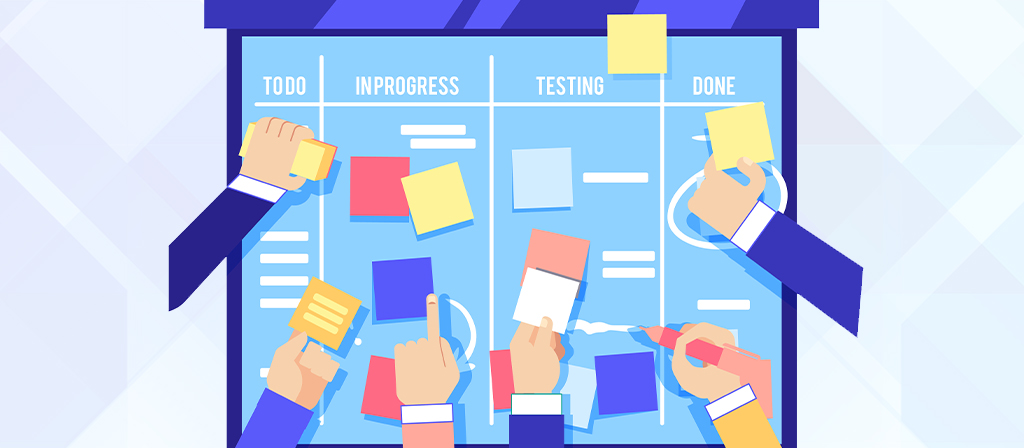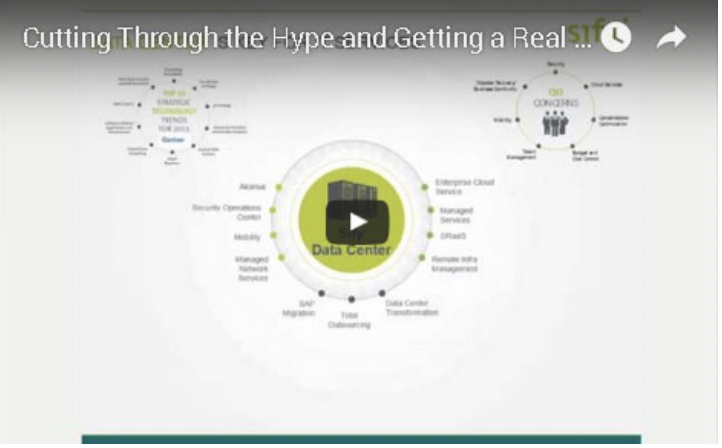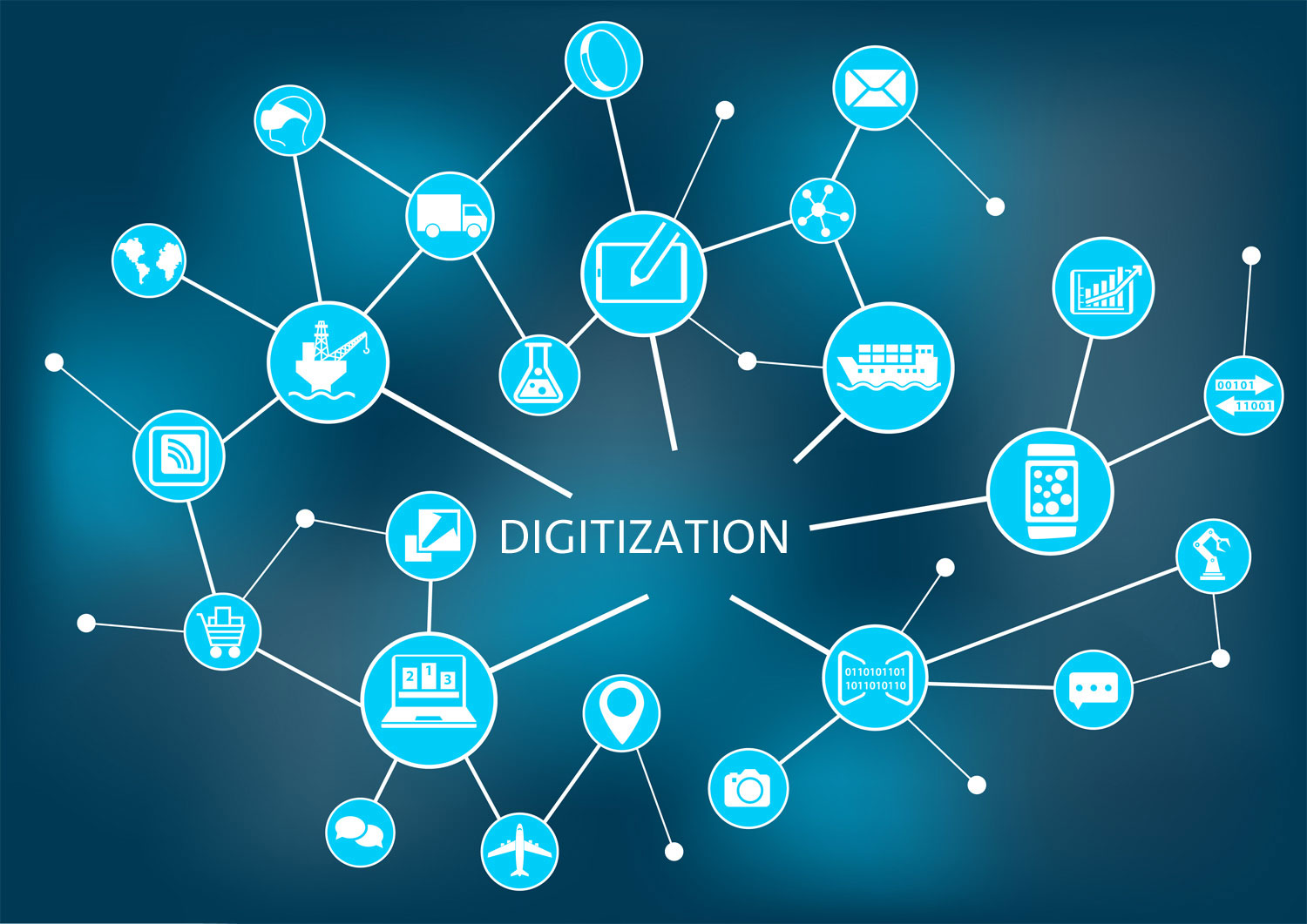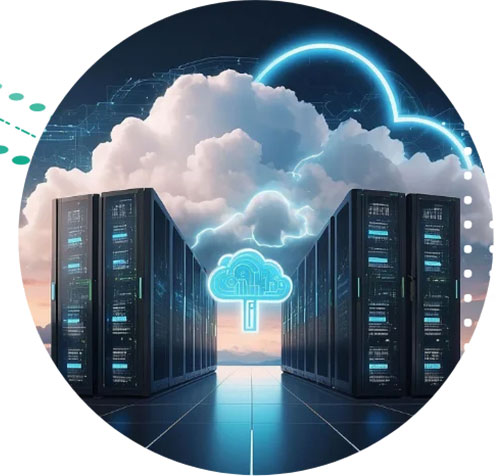How to use Acceptance Criteria to deliver high quality Product Features
Credits: Published by our strategic partner Kaiburr
As a Product Manager, when you define features for development and / or enhancement, it is important to ensure that the requirements are well-defined and unambiguous. This ensures that the product is built according to the vision and intent that you have for it.
Lack of rigorous, well-defined Acceptance Criteria can lead to delays and even poorly built products which do not answer the need for which they were intended.
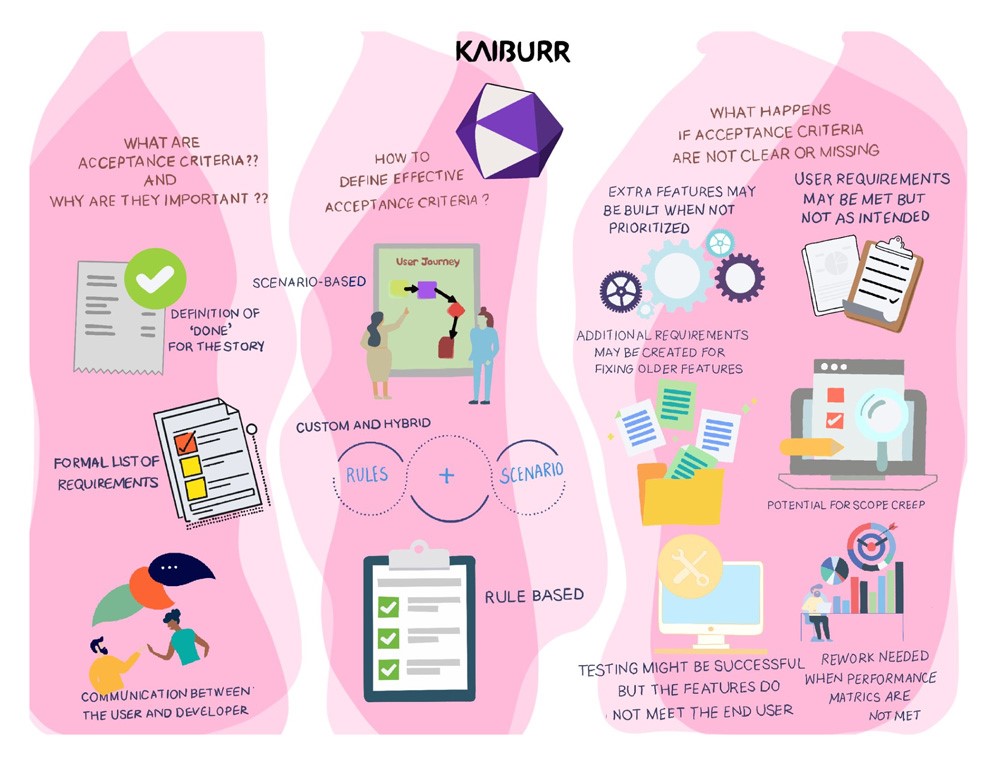
What are acceptance criteria and why are they important
- Acceptance criteria in a story are the definition of ‘done’ for the story.
- They are a formal list of requirements that describe a set of features, capabilities, conditions that meet the user’s needs as defined in the story.
- Acceptance criteria set the bounds for the story and the scope of the work the story entails.
- They are a key piece of communication between the user / client / product owner and the builder / developer.
- While they do not define the implementation details and ‘how’ the story must be built, the acceptance criteria define ‘what’ requirements must be met for the story to be considered ‘done’.
- This allows the development teams to design and build the user story with a clear idea of what must be built and what must be tested.
Acceptance criteria should define:
- current or pre-existing features / functions that will be used or are assumed to already be available if applicable
- change in any existing user action / behavior
- checks on the user actions that must pass
- negative scenarios
- appropriate error handling and alerting
- outcome of user action / behavior
- key performance / speed / metric for system performance as relevant
- functions / features that are not in scope if applicable
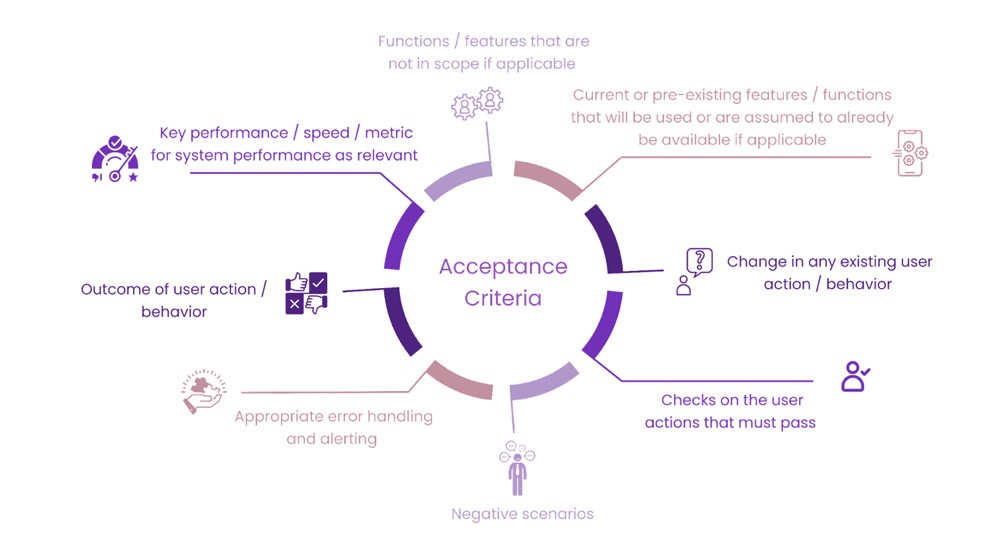
Who defines acceptance criteria:
Usually acceptance criteria are defined by consensus. Ideally the user behavior and system performance expectation, as perceived by a user, should be defined by the Product Manager. Additional standards that must be met for performance, tracking and internal system use may be defined by the Development and Operations teams as well.
What are effective acceptance criteria:
There are several ways to define acceptance criteria and depending upon the type of product and user story, different methods may be more relevant or easier to implement.
Before jumping into the actual methods that may be used to define acceptance criteria, the following points must be kept in mind:
- Anyone who reads the acceptance criteria should be able to understand them
- Must define ‘What’ must be done not ‘How’ it must be done
- Must always be from the user’s perspective
- Must be specific, clear, concise and testable
- Must be within the scope of the story
How to define effective acceptance criteria
- Scenario-based acceptance criteria define the user journey or user experience through describing various scenarios that the user will encounter and how the experience must be handled.
Example: A user has the choice of several options for choosing and customizing a widget that we build for them: The navigation paths that are possible and allowed should be detailed.
- A picklist of standard sizes of the product
- An option to create a custom size for certain features of the widget by going to a different page on the app or browser.
- Returning to the original screen with the customization saved.
- A choice of finishes.
- A choice of delivery options.
- A choice of shipping options.
- A payment method and transaction with confirmation.
- The acceptance criteria must detail which paths are valid, which paths are complete and what happens when a path is completed, or left incomplete.
- The user may be able to save some customization to their account or profile.
- The user may be able to share the customization to external parties or not etc.
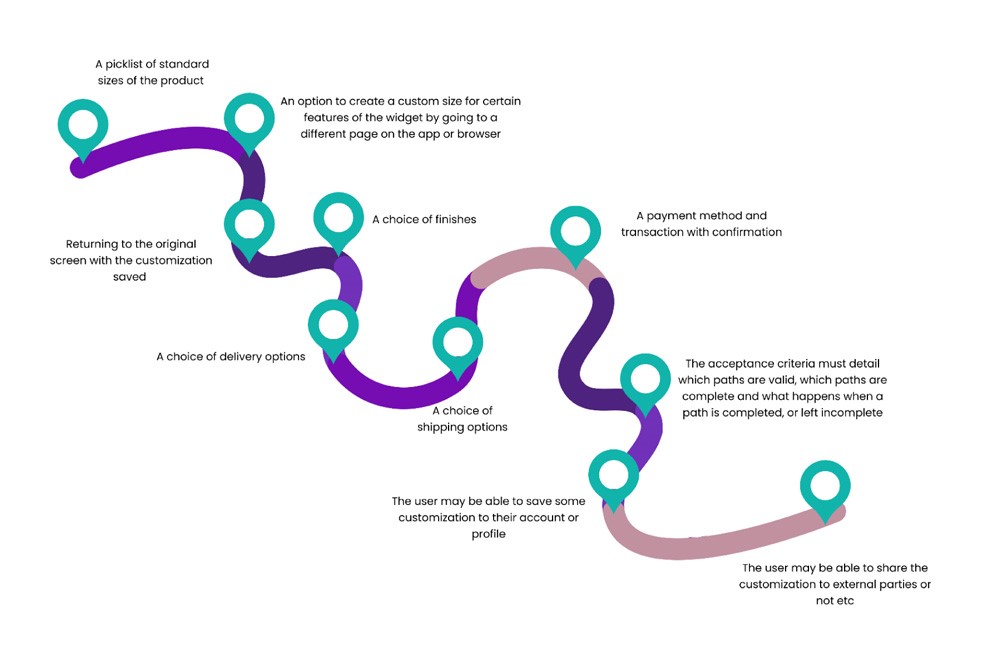
- Rule based acceptance criteria usually list a set of criteria that must be met for the story to be ‘done’. These include display fields and branding colors / logos etc. , size, appearance and shapes of visual elements.
Example: A landing page for a first time or returning user, who is requested to create an account or login with existing account:
- The logos and standard branding colors for the page or app are displayed.
- Check for existing users with email or userid as the case may be.
- Checks for password requirements for strength.
- Checks for MFA rules.
- Checks for recovery options etc.
- Custom and hybrid Rules+Scenarios used together are, not surprisingly, the most common form of defining acceptance criteria for complex product features, where both Scenarios of user experience are defined along with specific Rules and additional testable descriptive requirements.
No one way of defining criteria is better than another, and the best way is usually the one that answers all questions that any reader of the story may have, be it from the product team, development team, executive sponsor or another product and project stakeholder.
What happens if acceptance criteria are not clear or missing:
Unclear acceptance criteria can cause many headaches and derailments in the product development process:
- User requirement may be met but not in the way intended by the product manager / or described in the product roadmap.
- Testing may be successfully completed but the feature does not meet the user’s needs.
- Rework may be needed or additional requirements may be created for fixing or changing older features affected by current change.
- Rework is needed as performance metrics are poor or not met.
- Error handling for negative scenarios is ambiguous or undefined.
- Extra features / functions may be built when not needed or prioritized.
- Potential for scope creep
- Additional spending of resources – time and money – to ‘fix’ the story
Kaiburr helps identify stories missing acceptance criteria like the example below –

With just 15 minutes of configuration, Kaiburr produces real time actionable insights on end-to-end software delivery with 350+ KPIs, 600+ best practices and AI/ML models. Kaiburr integrates with all the tools used by the enterprise Agile teams to collect the metadata and generates digital insights with a sophisticated next generation business rules engine.
Reach us at marketing@sifycorp.com to get started with metrics driven continuous improvement in your organization.
Credits: Published by our strategic partner Kaiburr
Streamlining the IT Service Organization
Managed services on canonical model secures higher uptime, enhanced visibility and customer delight for billion-dollar chemical manufacturer
Project Objective
Enhance the client’s IT Services and jointly work towards meeting the business dynamics and challenges of IT Service Organization.
Project Model
Services model
Sify’s Uniqueness
Integrated value proposition:
- Support this customer with our strong management & monitoring toolsets, service-catalogue-based delivery for Data Center, Disaster Recovery Services, Network, Security, Service Desk & End-User Services.
Integrated Value and Outcome
Deliver comprehensive managed services on a canonical model modeled into a service catalog and outcomes linked payments
- Seamless service transition to Sify Managed Services
- Manage DC, DR, Network, Security, End-User Services.
- Savings in telecom bills through Network Assessment Services
- Cost reduction by migrating on-premise DC to Sify DC
- Improved DR Services levels by Sify DRaaS Services
- Cost reduction in Managed Services by improving productivity and reducing costs with hybrid Managed Services
- Continuous improvement in IT Services reliability and scalability leveraging Sify hybrid cloud platform
Value for client
Higher uptime of service levels, improvement in customer delight, service dashboard providing a view on the IT services, state-of-the-art tools, process and procedures, secure application access through BYOD platform, Reduced cost of DC operations and improved uptime of Infrastructure.
How Data Center forms the epicenter of IT infrastructure
SPEAKERS:
Kirtikar Ojha, Business Head – Data Center Services, Sify Technologies
DATE:
Wednesday, December 02, 2015
DESCRIPTION:
Businesses are becoming more and more Information-driven. As data becomes the most important organizational asset; Data Centers need to be reliable, safe, optimized, efficient and manageable and de-risked, because any risk to data would have a seismic impact on the entire business. How to formulate a comprehensive Data Center strategy? Find out in this webinar
Sify Technologies to Deliver 400G-ready Metro Networks Using Ciena’s WaveLogic Ai Technology
Leading ICT Solutions and Services provider in India adds significant capacity and greater network intelligence
HANOVER, Md. and CHENNAI, India – June 28, 2018 – Sify Technologies Limited (NASDAQ: SIFY), an acknowledged ICT leader in the Indian Telecom and Data Center centric IT services space with global delivery capabilities, has selected Ciena’s (NYSE: CIEN) converged packet optical solutions to address rising customer demand and provide greater support for increasing data volumes, the Internet of Things (IoT), cloud-based services and Big Data analytics.
Sify can now scale its network capacity from 100G to 400G to deliver ultra-high, data-heavy bandwidth services and manage unpredictable traffic growth for its customers, which include Over the Top (OTT) providers, financial services institutions and healthcare organizations.
Key Facts:
Sify Technologies Limited is an information and communications technology provider (ICT) offering end-to-end solutions delivered over a telecom data network reaching more than 1,550 cities and towns in India.
With the growing adoption of both private and public clouds in India, bandwidth demand for connecting Data Centers and cloud providers is growing exponentially. Sify’s Data Center Interconnect and Cloud Interconnect offerings are designed to deliver the required bandwidth and performance characteristics for reliable and cost-effective solutions that power the cloud strategies of large enterprises in the financial services, media and digital verticals. Today, Sify’s Data Center Interconnect footprint covers more than 40 Data Centers in India. The Cloud Interconnect offering provides on-demand access to leading public cloud and SAAS providers in India. The Ciena deployment helps Sify scale its network on demand and provides the key network characteristics to support its customers’ requirements.
By leveraging Ciena’s Waveserver Ai and 6500 Packet-Optical Platforms powered by WaveLogic Ai coherent technology, Sify can program its network to adapt to changing service requirements in real-time while supporting large capacities in the metro networks.
Another key attribute of this deployment is Ciena’s advanced software capabilities, including PinPoint™ software that will allow Sify to address with precision any potential trouble spots, reducing the risk of outages and accelerating repair times from days to hours. Additionally, Ciena’s Blue Planet Manage, Control and Plan (MCP) software will give Sify real-time software control and improve network visibility.
Executive Comments:
“The elasticity of our network to support multi-cloud, multi-Data Center scenarios and its programmability to monitor, control and adapt to meet user demands in real-time is critical. Ciena’s understanding of our network infrastructure and their clarity in where and how we would benefit from integrating their solutions for more flexibility and scale in the network, especially in the context of Data Center/cloud driven east-west traffic, made them the right fit for our growth plans.”
Daniel Alex, President Telecom Business, Sify Technologies Limited
“As Sify Technologies supports more users, digital applications and connected things across India, they face the challenge of adapting to the demands being placed on their network. Ciena is committed to supporting Sify Technologies through its extensive experience and expertise, to deliver a more programmable infrastructure aided by software control and analytics to respond to changing network demands intuitively.”
Ryan Perera, Vice President and General Manager, Ciena India
About Sify Technologies
Sify Technologies Limited (NASDAQ NM: SIFY), is an acknowledged ICT leader in the Telecom and Data Center centric IT services space with global delivery capabilities. Among the very few Enterprise class players in India, Sify, today has presence in more than 1550 cities in India and offices in North America, United Kingdom and Singapore.
More than 8500 Enterprises access Sify’s IT services that’s focused on the Data Center and Cloud platform and connected through India’s largest MPLS network. As a truly converged ICT solutions and services provider, Sify is the preferred IT Services partner with a full suite of services ranging from Telecom connectivity services to Data Center transformation services along with Application and Security Services delivered on the same infrastructure.
Sify, Sify Technologies and www.sifytechnologies.com are registered trademarks of Sify Technologies Limited
About Ciena
Ciena (NYSE: CIEN) is a network strategy and technology company. We translate best-in-class technology into value through a high-touch, consultative business model – with a relentless drive to create exceptional experiences measured by outcomes. For updates on Ciena, follow us on Twitter @Ciena, LinkedIn, the Ciena Insights blog, or visit www.ciena.com.
Note to Ciena Investors
You are encouraged to review the Investors section of our website, where we routinely post press releases, SEC filings, recent news, financial results, and other announcements. From time to time we exclusively post material information to this website along with other disclosure channels that we use. This press release contains certain forward-looking statements that are based on our current expectations, forecasts, information and assumptions. These statements involve inherent risks and uncertainties. Actual results or outcomes may differ materially from those stated or implied, as a result of risks and uncertainties, including those detailed in our most recent annual or quarterly report filed with the SEC. Forward-looking statements include statements regarding our expectations, beliefs, intentions or strategies and can be identified by words such as “anticipate,” “believe,” “could,” “estimate,” “expect,” “intend,” “may,” “should,” “will,” and “would” or similar words. Ciena assumes no obligation to update the information included in this press release, whether as a result of new information, future events or otherwise.
For further information, please contact:
Sify Technologies Limited
Mr. Praveen Krishna
Investor Relations & Public Relations
+91 44 22540777 (ext.2055)
Digital disruption, an opportunity to create adaptive businesses
The biggest digital disrupter of the decade has finally hit the IT industry! The convergence of new technologies – social, mobile, cloud and data analytics, has fundamentally changed the way business is being done. Enterprises are, naturally, under immense pressure to adapt their existing infrastructures, strategies and workforce to deal with these changes.
But during this hectic time, businesses need to pause and reflect on how they want digital transformation to impact their long-term strategy and growth. Do they want to fire fight the next wave of disruption or be ahead of the curve? Do they want to patch on technology cures or create a future ready system?
To ensure that digital transformation finally results in a strong and adaptive business structure, here are the 5 key areas of consideration
Invest in creating a Digital Vision
Transformation is a top down process: senior management, from across all departments, need to come together to create a long term and holistic strategy to deal with enterprise digital transformation.What is needed is a digital vision to articulate the immediate impact and long-term opportunities that could come up due to the transformation process.
100% Customer focused approach
To create a truly future focused and adaptive business, the customer must be kept at the center of all business functions: this is the fundamental on which enterprises need to base their long and short term digital strategy.
Enterprises that listen to its customers, present and potential, are the ones that will, not just flourish in the current digital rich environment, but will be better prepared to ride the next wave of disruption. To build customer loyalty and a differentiated brand, customer engagement has to be amped up to deliver continuously improving and truly interesting and innovative 360° customer experience.
Follow the data, but with a context
Even though organizations are using Analytics and Big Data mining to improve their bottom-line, often the sheer amount of data can leave managers with a sense of uncertainty.
What is needed here is Context. An open communication structure within the organization will encourage employees from different departments to weigh in on how to interpret and use the data.
Transform your employees
Transformation will only work as well as the people running it. For many employees digital transformation can be a disruptive and challenging process and targeted training and change management will help to keep the workforce motivated.
To change ingrained mindsets is not an easy task, but to create an agile business, inter departmental collaboration must become part of the work culture. Employees, new or existing, must be encouraged to stay updated and learn digital skills and should be assessed on their ability to contribute to the new system.
Embrace the culture of Innovation
Finally, organizations have to foster a deep-rooted culture of innovation and experimentation. Talented teams from across departments must collaborate to constantly experiment and test new technologies and processes to reach more and more digital users. This quick thinking and agile workforce will create a business that is not just ready to manage the next big change but will actually create the next new technology disruptor.
Digital transformation is not an end in itself; it is a continuous process. For enterprises to constantly stay ahead of the curve, digital culture must seep into its very core. It changes not just how companies deal with its customers, but also impacts its internal structures, functions and processes. It becomes part of the organization’s DNA.
We are Sify and we transform businesses for a digital world like no other. With our SMAC network, global inter-cloud connectivity, agile IT and seamless access across platforms, we transform the way enterprises do businesses providing a unified customer experience.
Journey to a digital platform – 5 challenges businesses need to overcome
The IT industry is no stranger to digital disruption, over the last 3 decades, new trends and technological leaps have time and again changed the direction of the industry. The first wave in 1990s permanently transformed industries such as music, photography and video rental and the 2000s saw major disruption in industries like television, travel and recruitment. We now face the third wave of digital disruption, brought on by the huge amounts of rich data produced by social media and mobile technologies.
How quickly and efficiently businesses respond to this challenge, will determine whether they will be competitive and profitable in the coming decades.
Challenges of Digital Transformation
State of existing IT
Business need to know where they stand in terms of their IT readiness.For digitally mature organizations the change is manageable, but some businesses might have to restructure and invest more deeply to embrace the digital environment.
Change Management
The digital way of working is based on openness and creativity; it promotes a flatter and less controlled organization. Enterprises need to embrace and incorporate this into their work culture and existing workforce must be motivated to join this new work culture with an open mind.
Digital Employees
For a business to succeed in a digital world, it needs to be staffed with people who live digital and breathe data. To fully understand the digital experience offered to customers, managers have to be comfortable with the technology themselves.
Customer is the king
Customer experience must remain the primary focus while designing and implementing digital systems. How you want to engage and service your customer? What are the business models that you offer? These are some of the questions that will drive your ultimate digital goal.
Leadership
Clear vision and strong leadership are two vital factors for long term Digital Success. Digital transformation is a top down process and a focused leader with a clear, detailed roadmap will successfully lead the organization through its digital journey.
Transformation, digital or otherwise, is crafted and enacted by people. Therefore, it’s no surprise that the success of digital transformation lies more with employees, managers and other stakeholders rather than implementing technologies. The right people will enable organizations to deal with, not just this wave of digital disruption, but all future changes that come their way.
We are Sify and we transform businesses for a digital world like no other. With our SMAC network, global inter-cloud connectivity, agile IT and seamless access across platforms, we transform the way enterprises do businesses providing a unified customer experience.
Cognitive Computing Turning IT Operators into IT Innovators
Cognitive Computing: Turning IT Operators into IT Innovators
We are on the cusp of a new age of computing. One where smart businesses are starting to think differently about how they design, build, and deliver technology solutions. We believe that IT teams need rise up and help drive this innovation.
That’s why we’re collaborating to help our clients apply the power of cognitive insights to transform their businesses. This starts with a perception shift.
Technology as the Job Maker, Not the Job Taker
So much of what you hear about technology today puts technology in the position of job taker. Conversations about which jobs computers and robots will make obsolete pop up frequently in conversations about the future of tech, business, and the economy.
We have advocated version of that view ourselves: Consolidate your servers and reduce the manpower needed to maintain your technology, outsource aspects of your technology as PaaS, SaaS, Iaas, cloud based, and so forth. This kind of efficiency is part of the story. BUT, we’ve worked hard to relay the second half of this story loudly (but maybe not always clearly).
Yes, this takes away tasks from your IT team, BUT it frees them up to focus on more mission-critical IT work.
IT teams have looked at these kinds of statements skeptically. What would their function be if it weren’t maintaining IT operations?
The Cognitive Computing Era
Welcome to the cognitive computing era, where that vision of IT experts focusing on mission-critical tasks is more of a reality than ever. In the cognitive era, technology no longer just supports the business. It BECOMES the business. Your IT infrastructure is the foundation of this, but IT professionals must do more than just keep the machines running. They must embrace the role of business innovator.
According to IDC, line-of-business leaders say that they perceive IT leaders as business innovators more than business operators. Yet, that same study found that IT leaders viewed themselves more as operators. It’s time for that to change.
The I in IT
Business leaders are recognizing that IT needs to be more tightly integrated into the overall business strategy. In order for this to happen, IT needs to be enabled and viewed as more than infrastructure architects.
IT needs to embrace the idea that they can use technology to drive the business forward. They need to throw off the idea that the I in IT just stands for Information. They need to come forward and proclaim that it stands for Ideas, Imagination, Invention—and that the core of all of that is Innovation.
Priming Your Business for the Cognitive Computing Era
In the cognitive computing era, data analytics has been cut from hours to milliseconds. Organizations have the ability to take action on data in real time. Machines are learning in the cognitive era. They’re learning how to help run businesses more efficiently.
None of this is possible without the right IT infrastructure. Today’s machines can understand, reason, and learn. Traditional IT environments work, but to take the leap into the cognitive, you need more.
We believe the core of this is through enhanced capabilities. In the coming weeks, we’ll dive deeper into the following capabilities:
- Analytics Acceleration
- Data Centric Design
- Innovate with Open Technologies
- Choice for Optimization
- Lock Down while Opening Up
- Controlled Iteration at Scale
When these capabilities are wrapped in the core principals of Design for Cognitive Business, Build with Collaborative Innovation, and Deliver through Cloud Platform, business can start to map out a path where IT is innovative.
Subscribe to our blog and hear us out. We’re ready to make the case for an IT team that is more than just the architects of the machines. They’re the architects of a new kind of business.




